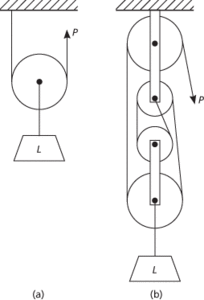A simple machine consisting of a wheel with a flat, crowned, or grooved rim to take a belt, rope, or chain with which a load can be raised.
In fig (a), assuming the system is frictionless, the force P in any part of the rope is constant; therefore 2P=L, where L is the load. In general, nP=L, where n is the number of supporting ropes. In fig (b), the number of supporting ropes is 4. The mechanical advantage of a pulley system is the ratio of the load, L, to the effort applied to the free end of the rope, P; i.e. mechanical advantage=L/P=L(L/n)−1=n. Thus in fig (b) the mechanical advantage is 4. A combination of ropes and pulleys as in fig (b) is called a block and tackle.

Pulleys.
A grooved wheel around which a rope can pass. When supported on an axle in some way, the device can be used to change the direction of a force: for example, pulling down on a rope may enable a load to be lifted. If the contact between the pulley and the axle is smooth, the magnitude of the force is not changed. A system of pulleys can be constructed that enables a large load to be raised a small distance by a small effort moving through a large distance. In such a machine, the velocity ratio is equal to the number of ropes supporting the load or, equivalently, the number of pulleys in the system.
- tense logic
- tensile strength
- tensile stress
- tensimeter
- tensiometer
- tension
- tension crack
- tension fracture
- tension gash
- Tenskwatawa
- tensor
- tensor calculus
- tensor product
- tentacle
- tent rocks
- ten’s complement
- tepee
- tephigram
- tephra
- Ardennes Campaign (16–26 December 1944)
- Arden’s rule
- ardipithecine
- Ardipithecus ramidus
- Arduino, Giovanni (1714–95)
- ARE